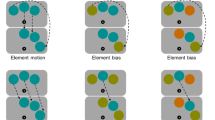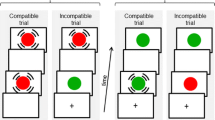Abstract
Duncan (1979) examined all combinations of compatible and incompatible stimulus-response mappings for two spatial three-choice tasks in the psychological refractory period paradigm. Performance was better when the mappings for the tasks were consistent than when they were not, even when both mappings were incompatible. He attributed the benefit for the consistent incompatible mapping to an emergent choice between mappings when they are inconsistent that slows performance. Consistent incompatible mappings also may benefit from emergent perceptual features. The present study examined the role of emergent perceptual and mapping-choice features in two experiments that used pairs of two-choice tasks. Results similar to Duncan’s were obtained with visual stimuli mapped to keypresses at short (stimulus onset asynchrony) SOAs. However, the benefit of the consistent incompatible mapping condition over the inconsistent mapping conditions was eliminated at an SOA of 1,000 ms. Furthermore, this benefit was not evident when the stimuli were auditory for Task 1 and visual for Task 2. With two-choice tasks, the benefit for consistent mappings apparently is due primarily to an emergent perceptual feature.










Similar content being viewed by others
References
Duncan, J. (1979). Divided attention: The whole is more than the sum of its parts. Journal of Experimental Psychology: Human Perception and Performance, 5, 216–228.
Ehrenstein, A., & Proctor, R. W. (1998). Selecting mapping rules and responses in mixed compatibility four-choice tasks. Psychological Research, 61, 231–248.
Ivry, R. B., Franz, E. A., Kingstone, A., & Johnston, J. C. (1998). The psychological refractory period effect following callosotomy: Uncoupling of lateralized response codes. Journal of Experimental Psychology: Human Perception and Performance, 24, 463–480.
Lien, M.-C., & Proctor, R. W. (2000). Multiple spatial correspondence effects on dual-task performance. Journal of Experimental Psychology: Human Perception and Performance, 26,1260–1280.
Lien, M.-C., & Proctor, R. W. (2002). Stimulus-response compatibility and psychological refractory period effects: Implications for response selection. Psychonomic Bulletin & Review, 9, 212–238.
Meyer, D. E., & Kieras, D. E. (1997). A computational theory of executive cognitive processes and multiple-task performance: I. Basic mechanisms. Psychological Review, 104, 3–65.
Pashler, H., & Johnston, J. C. (1998). Attentional limitations in dual-task performance. In H. Pashler (Ed.), Attention (pp. 155–189). Hove, UK: Psychology Press.
Proctor, R. W., & Vu, K.-P. L. (2004). Consistent mappings for dual tasks do not always yield better performance than inconsistent mappings. Paper presented at Conference on Process-Based and Code-Based Interference in Dual Tasks, Ohlstadt, Germany. (February)
Reeve, T. G., Proctor, R. W., Weeks, D. J., & Dornier, L. (1992). Salience of stimulus and response features in choice-reaction tasks. Perception & Psychophysics, 52, 453–460.
Tombu, M. & Jolicœur, P. (2003). A central capacity sharing model of dual-task performance. Journal of Experimental Psychology: Human Perception & Performance, 29, 3–18.
Yantis, S. (1996). Attentional capture in vision. In A.F. Kramer, M.G.H. Coles, G.D. Logan (Eds.), Converging operations in the study of visual selective attention (pp. 45–76). Washington, DC: American Psychological Association.
Acknowledgements
We thank Chris Burch, David Purpura, Robert Janik, and Kristina Schneider for their help in collecting data. We also thank John Duncan, Pierre Jolicœur, and Jochen Müsseler for helpful comments on an earlier version of this manuscript.
Author information
Authors and Affiliations
Corresponding author
Rights and permissions
About this article
Cite this article
Vu, KP.L., Proctor, R.W. Emergent perceptual features in the benefit of consistent stimulus-response mappings on dual-task performance. Psychological Research 70, 468–483 (2006). https://doi.org/10.1007/s00426-005-0021-7
Received:
Accepted:
Published:
Issue Date:
DOI: https://doi.org/10.1007/s00426-005-0021-7




